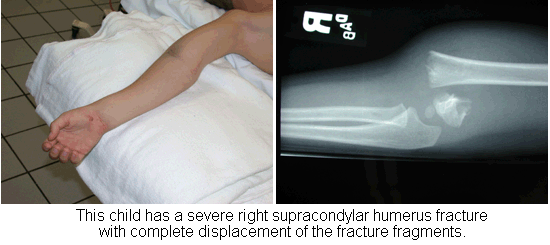Description
Whether your child is an active athlete or just a toddler jumping on the bed, there’s a good possibility that he or she will take a spill at home or on the field or court at some time. These falls are usually harmless; but when a child falls on an outstretched arm, the velocity of the fall combined with the pressure of hitting the ground could be enough to break a bone.
That’s how most fractures around the elbow joint occur. These fractures account for about 10 percent of all fractures in children.
If your child complains of elbow pain after a fall and refuses to straighten his or her arm, see a doctor immediately. The doctor will first check to see whether there is any damage to the nerves or blood vessels. X-rays will help determine what kind of fracture occurred and whether the bones moved out of place.
Because a child’s bones are still forming, the doctor may request X-rays of both arms for comparison.
Types of Fractures
A child can experience a fracture in several places about the elbow, including:
Above the elbow (supracondylar): The upper arm bone (humerus) breaks, slightly above the elbow. These fractures usually occur in children younger than 8 years of age. This is the most common elbow fracture, and one of the more serious because it can result in nerve damage and impaired circulation.
At the elbow knob (condylar): This type of fracture occurs through one of the bony knobs (condyles) at the end of the upper arm bone. Most occur through the outer (lateral) knob. These fractures require careful treatment, because they can disrupt both the growth plate (physeal) and the joint surface.
At the inside of the elbow tip (epicondylar): At the top of each bony knob is a projection called the epicondyle. Fractures at this point usually occur on the inside (medial) epicondyle in children between 9 and 14 years of age.
Growth plate: The upper arm bone and both lower arm bones have growth plates located near the end of the bone. A fracture that disrupts the growth plate can result in arrested growth and/or deformity if not treated promptly.
Forearm: An elbow dislocation can break off the head of the thumb-side lower arm bone (radius), and excessive force can cause a compression fracture to the bone as well. Fractures of the tip (olecranon) of the other lower arm bone (ulna) are rare.
Fracture dislocation: A fracture of the inside bone (ulna) can be combined with the top of the thumb-side bone (radius) coming out of the socket at the elbow. This is called a Monteggia fracture. If the dislocation is not seen, and only the fracture is treated, this can lead to permanent impairment of elbow joint function.

Risk Factors / Prevention
If your child is an active athlete, make sure that he or she wears the proper protective equipment. Elbow guards and pads can help reduce the risk of a fracture about the elbow.
Symptoms
Regardless of where the break is, the symptoms of a broken elbow are similar:
- Acute pain
- Tenderness
- Swelling (may be severe or mild)
- Limited movement
Treatment Options
Treatment depends on the type of fracture and the degree of displacement. If there is little or no displacement, the doctor may immobilize the arm in a cast or splint for 3 to 5 weeks.
During this time, another set of X-rays may be needed to determine whether the bones are staying properly aligned.
If the fracture forced the bones out of alignment, the doctor will have to manipulate them back into place. Sometimes, this can be done without surgery, but more often, surgery will be needed. Pins, screws or wires are used to hold the bones in place. The child will have to wear a cast for several weeks before the pins are removed.
Range of motion exercises can usually begin about a month after surgery.

